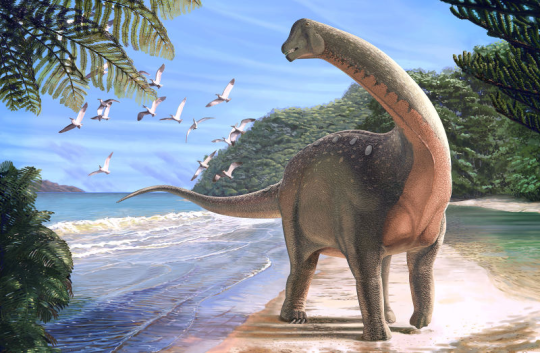
By Matt Lamanna
It might sound a little strange to say, but African dinosaurs have been an important part of my life for a long time. Almost two decades ago, when I was in graduate school at the University of Pennsylvania, and a few years before I took a job here at Carnegie Museum of Natural History, I participated in fossil-hunting expeditions to the Sahara Desert of Egypt. Along with our advisor, my beloved “Boss” Peter Dodson, my fellow students and I had a lot of success, discovering among other fossils the only known skeleton of a new, ~95 million-year-old species that we named Paralititan stromeri in 2001. With a humerus, or upper arm bone, that’s almost as tall as I am, Paralititan is still one of the biggest dinosaurs known to science.
But as fun as those discoveries were to be a part of, some of our team’s most sought-after finds never materialized. In going to Egypt, part of our aim was to find dinosaurs from roughly 80 to 66 million years ago – dinosaurs from the very end of the Cretaceous Period, the third and final time period of the Age of Dinosaurs. Dinosaur fossils of this age are exceedingly rare on all of continental Africa (i.e., Africa excluding the island of Madagascar), not just in Egypt. Surprisingly, however, this has not stopped paleontologists from speculating as to what kinds of dinosaurs might have inhabited Africa at the end of the Cretaceous. Some have proposed that African latest Cretaceous dinosaurs were close relatives of, and therefore similar to, those living on neighboring landmasses at the same time. Other scientists have argued that Africa was an island continent at the end of the Cretaceous, and, because it was cut off from other land areas, it was home to unique dinosaurs that had evolved for millions of years along their own distinctive evolutionary pathways.
Until recently, no one had ever found a reasonably complete dinosaur skeleton from the end of the Cretaceous anywhere on continental Africa. A few isolated bones and minor parts of skeletons had been discovered, but these didn’t tell us much about the dinosaurs to which they belonged – as you can imagine, the more pieces one has of a fossil skeleton, the more one can typically learn about the animal it represents. This, in turn, prevented paleontologists from figuring out whether African latest Cretaceous dinosaurs were truly unique or whether they had close kin on other landmasses. But all of that changed in late 2013, when my friend and colleague Dr. Hesham Sallam of Mansoura University in Egypt—along with his talented students Iman El-Dawoudi, Sanaa El-Sayed, and Sara Saber—discovered the skeleton of a sauropod (long-necked plant-eating dinosaur) at an ~80 million-year-old site in the Dakhla Oasis of the Egyptian Sahara. The dinosaur I’d dreamed about for virtually all of my professional life had finally been found! Even better, Hesham and the team—which also included my close friends Pat O’Connor and Eric Gorscak, plus several other Egyptian and American scientists—invited me to be a part of the study. We soon realized that the creature had a lot to say about the nature of Africa’s last dinosaurs, as its bones suggested close relationships to species living in Europe and Asia at about the same time. These hypotheses were borne out by more rigorous analyses, showing that African latest Cretaceous dinosaurs weren’t island-dwelling weirdos after all – rather, they had close cousins in Eurasia. Today, our team gave the dinosaur its formal scientific name, Mansourasaurus shahinae, and for me, it’s the culmination of a search that’s occupied almost half my life.
Matt Lamanna is a paleontologist and the principal dinosaur researcher at Carnegie Museum of Natural History in Pittsburgh.
Museum employees are encouraged to blog about their unique experiences and knowledge gained from working at the museum.
Read more about this news on Gizmodo.
